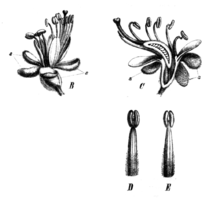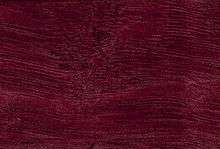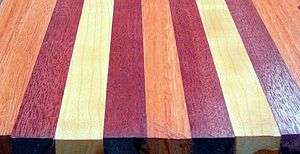Peltogyne
Peltogyne, commonly known as purpleheart, amendoim, violet wood, amaranth and other local names (often referencing the colour of the wood) is a genus of 23 species of flowering plants in the family Fabaceae; native to tropical rainforests of Central and South America; from Guerrero, Mexico, through Central America, and as far as south-eastern Brazil.[2]
| Peltogyne | |
|---|---|
 | |
| Peltogyne paniculata | |
| Scientific classification | |
| Kingdom: | |
| (unranked): | |
| (unranked): | |
| (unranked): | |
| Order: | |
| Family: | |
| Subfamily: | |
| Genus: | Peltogyne |
| Species | |
|
See text | |
| Synonyms[1] | |
| |
They are medium-sized to large trees growing to 30–50 m (100–160 ft) tall, with trunk diameters of up to 1.5 m (5 ft). The leaves are alternate, divided into a symmetrical pair of large leaflets 5–10 cm (2–4 in) long and 2–4 cm (1–2 in) broad. The flowers are small, with five white petals, produced in panicles. The fruit is a pod containing a single seed. The timber is desirable, but difficult to work.
Distribution
The species of the genus range from southeastern Brazil through northern South America, Panama, Costa Rica, and Trinidad, with the majority of species in the Amazon Basin. P. mexicana is a geographic outlier, native to the Mexican state of Guerrero.[3] Overharvesting has caused several species to become endangered in areas where they were once abundant.[4]
Wood
The trees are prized for their beautiful heartwood which, when cut, quickly turns from a light brown to a rich purple color. Exposure to ultraviolet (UV) light darkens the wood to a brown color with a slight hue of the original purple.[5] This effect can be minimized with a finish containing a UV inhibitor. The dry timber is very hard, stiff, and dense with a specific gravity of 0.86 (860 kg/m3 or 54 lb/cu ft). Purpleheart is correspondingly difficult to work with.[6] It is very durable and water-resistant.
Uses and hazards
Purpleheart is prized for use in fine inlay work especially on musical instruments, guitar fret boards (although rarely), woodturning, cabinetry, flooring, and furniture. The timber is also valuable in applications that require toughness, such as truck decking.[7]
Exposure to the dust generated by cutting and sanding purpleheart can cause irritation and nausea, possibly due to the presence of dalbergione (neoflavonoid) compounds in the wood. This also makes purpleheart wood unsuitable to most people for use in jewelry.[8] Purpleheart is also a fairly expensive wood, which is why it is usually used in smaller-scale projects.[9]
Gallery


 Peltogyne sp. - MHNT
Peltogyne sp. - MHNT
Species
- Peltogyne altissima Ducke
- Peltogyne angustiflora Ducke
- Peltogyne campestris Ducke
- Peltogyne catingae Ducke
- Peltogyne confertiflora (Hayne) Benth.
- Peltogyne discolor Vogel
- Peltogyne excelsa Ducke
- Peltogyne floribunda (Kunth) Pittier
- Peltogyne gracilipes Ducke
- Peltogyne heterophylla M.F.Silva
- Peltogyne lecointei Ducke
- Peltogyne maranhensis Ducke
- Peltogyne mattosiana Rizzini
- Peltogyne mexicana Martinez
- Peltogyne paniculata Benth.
- Peltogyne paradoxa Ducke
- Peltogyne parvifolia Benth.
- Peltogyne pauciflora Benth.
- Peltogyne prancei M.F.Silva
- Peltogyne purpurea Pittier
- Peltogyne recifensis Ducke
- Peltogyne subsessilis W.A.Rodrigues
- Peltogyne venosa (M.Vahl) Benth.sfd
References
- R. C. Barneby (1983). "(711)-(712) Proposals to conserve Plathymenia against Echyrospermum and Peltogyne against Orectospermum (Leguminosae)". Taxon. 32 (3): 488–490. JSTOR 1221525.
- Sotuyo, Solange. "El palo morado (Peltogyne mexicana), una leguminosa maderable con futuro incierto y parientes lejanos". Revista Digital Universitaria, Universidad Nacional Autónoma de Mexico.
- Sotuyo, Solange. "El palo morado (Peltogyne mexicana), una leguminosa maderable con futuro incierto y parientes lejanos". Revista Digital Universitaria, Universidad Nacional Autónoma de Mexico. Accessed 25 April 2015.
- "Purpleheart - Peltogyne - Madera Sudamerica -Consorcio forestal". Maderasdesudamerica.com.
- "PURPLEHEART-PELTOGYNE".
- Garnet Hall (February 2006). The Art of Intarsia: Projects & Patterns. Tamos Books, Incorporated. pp. 16–. ISBN 978-1-895569-75-9.
- "Purpleheart Wood".
- Peltogyne in BoDD – Botanical Dermatology Database
- J. L. Atrops (1970). Strength Properties of Trinidadian Timbers. University of the West Indies.
- International Legume Database: Peltogyne
- Virtual Flora of Guyana: Peltogyne herbarium photos
- Especies de Costa Rica: Peltogyne purpurea (in Spanish)
- Baker, Mark (2004). Wood for Woodturners. Sussex: Guild of Master Craftsmen Publications. ISBN 1-86108-324-6.
| Wikimedia Commons has media related to Peltogyne. |